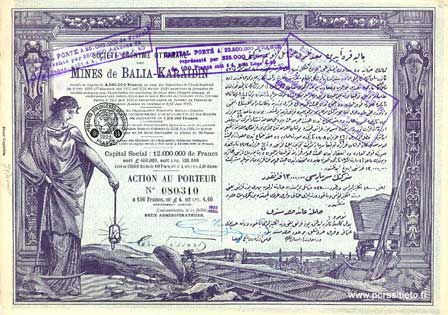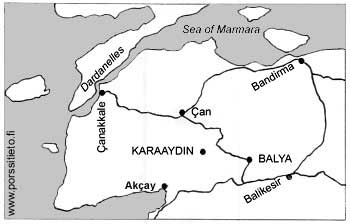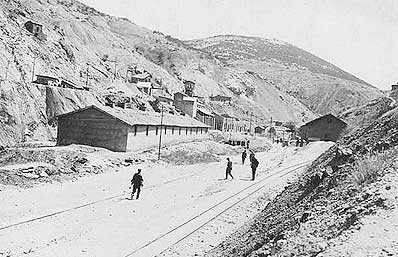|
© G.
Kock 2009
Société Anonyme Ottomane des
MINES DE BALIA-KARAÏDIN
Balya-Karaaydın Madenleri
Osmanlı Anonim Şirketi

CLICK ON IMAGE TO ENLARGE IT
THE MINES
The towns or villages of Balia Maden and Karaïdin (Turkish: Balya,
Karaaydin) are situated some 50 kilometres south of the Sea of
Marmara, which is SW of Istanbul, in the then Vilayet of
Broussa (Bursa). The Balya lead-zinc-silver deposit had been worked
since antique times and was the main producer of lead and silver in
Turkey during the Company's time. 400,000 (metric) t of lead,
400,000 t of zinc metal, 1,000 t of silver and 3 t of gold from a
total of 4 million t of ore was produced (Humboldt-Wetherill
separator) during this period of surface mining on an industrial scale,
1880–1939. Mainly exported to France (but 1901–13 the whole lead
output was bought by Metallgesellschaft). The population of Balya fell
from 36,000 to today's 2,000 and environmental pollution in the
Kocaçay River is
still a huge problem. There are large ore reserves left
and exploration continues. A modern view
of Balya town [www.balikesirnvm.gov.tr].

Pronounciation: aa, kk as separate letters,
c
like j in jet, ç ch, ı like er in farmer, i ee,
ş sh, y
like y in yes. Every letter is pronounced (exc. ğ).
THE COMPANY
After a couple of abortive German (Reiser) and other French investment efforts since 1867
the Balia-Karaidin Mines Ottoman Joint Stock Company was founded in
1892, with the powerful Ottoman Bank (Constantinople) as initiator in co-operation with
Banque de Paris et de Pays-Bas, to take over the concession. E.g. the banker Mavrogordato and WW1 arms
dealer Sir Basil Zaharoff (both Greek) also had interests. Now mining started
on a large scale, although the roads were hardly usable. At first brown coal was utilised
for energy, but in 1901 a
thermal (coal) power plant for electricity, Anatolia's first, was set up by the French at
Mancılık. The Company had lignite deposits there. A
narrow-gauge railway was built from Balya southwards to the road leading to the little
shipping port of Akçay on the Gulf of
Edremit. In 1908 the first labour strike in Turkey took place in Balya. In 1913
the Company was one of the world's big mining enterprises, but during the war it was forced to pause operations in the
enemy country. After WW1 the area was briefly under Greek occupation.
In 1924, after the fall of the Ottoman empire, it became a Turkish joint stock company: Balia-Karaidin Turkish Mining Company. The
main owners and management were French, 40 p.c. of the clerks were Greek
and there were 4–5,000 Turkish workers. The Company was leasing
and operating the mines from and on behalf of the state – but since 1928 at a loss.
It also engaged in participations like Makri (Fethiye) chrome. A 1927 fire in one of the
quarries had caused damage that could not be
compensated for by the governement aid. In 1931
it attempted transferring the mine operating activities to another company and
again received government financial assistance, but had to totally stop functioning
in 1935 because due to the depression world market prices had fallen too
low. Then it was in liquidation
from 1940 until 1950(?). The machinery was disassembled. Of the sites' buildings
there are now only ruins left. Local companies had tried without success to
partially continue mining for some years.
THE SHARE CERTIFICATE
The Balia-Karaidin Company's decorative and exotic-looking stock
certificate, pictured above, is now one of the most common
old foreign and Turkish certificates, because all the 400,000 shares
apparently became
valueless. They are therefore, fortunately, inexpensive and continually
available to today's scripophily collectors from many sellers since years.
The certificates were printed by Vieillemard (at least the late ones) of Paris in the size
31x21 cm,
excluding the attached unused coupons (usually from no. 23 onwards). They
have an
attractive vignette and is inscribed in French and in old Ottoman Turkish script.
(Some dealers claim the female is Pallas Athene/Minerva, but that is
not true.) Issues of at least the following dates are represented on the market:
1 Sept. 1904, 15 Aug. 1908, 15 July 1913, 15 July 1920, 10 June 1921, 10
Nov. 1922, 30 Nov. 1922, 20 Feb. 1923, 25 Nov. 1923, 25 Dec. 1923, 25 Dec.
1924, 30 Jan. 1926 and 20 May 1926, i.e. most of them from the years after WW1.
In 1900 the Company decided to change the face value to 100 French Francs and therefore
every certificate was obviously replaced in 1904 in connection with the
increase of the share capital. The papers are all of the same design and similar in
colour (some issues are more reddish than the above copy of 15 July 1920) and all certificates seen are
for one free bearer share each. The
late (1926) certificates are inscribed
"Turque" instead of "Ottomane", and they are the most common. The original
share capital of 4.5 million Francs was increased to 6 million in 1904 and
finally to 40 million in 1926. The shares, issued and dated in
Constantinople (now Istanbul), were quoted on the Paris stock exchange and paid good
dividends up to 1914.
Ulkomaiset
osakekirjat.
Scripophily in Finland;
auf Deutsch.
España Industrial. Banque Industrielle Chine.
Kilo-Moto.
Web address of this page:
www.porssitieto.fi/kirjoitus/balia-karaidin.html

|